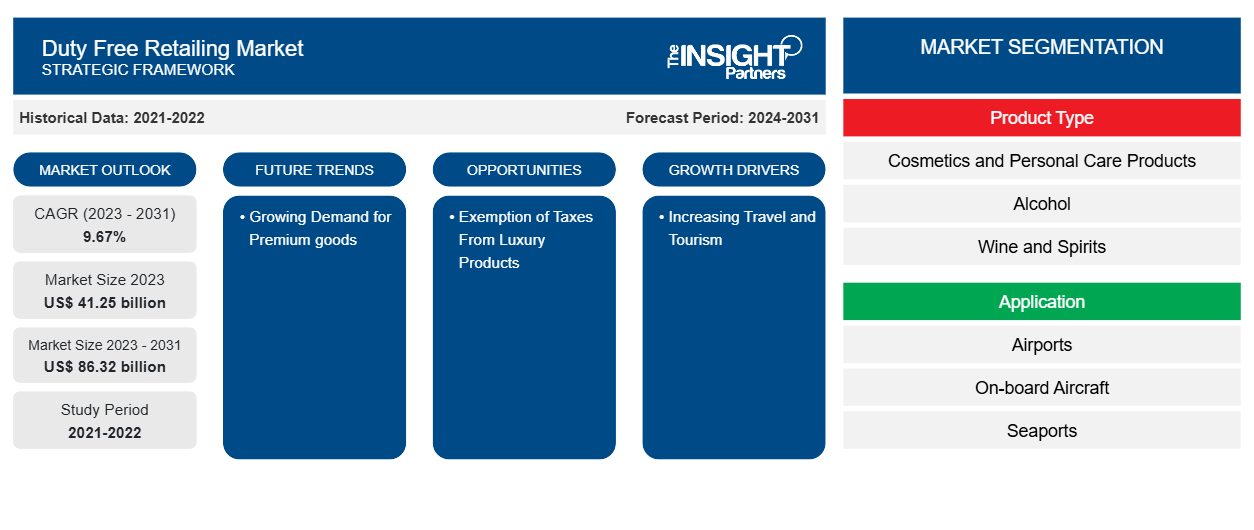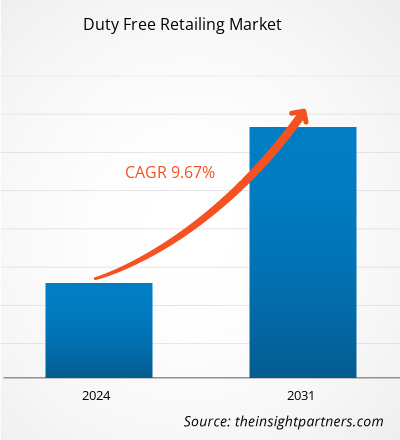The duty free retailing market size is projected to reach US$ 86.32 billion by 2031 from US$ 41.25 billion in 2023. The duty free retailing market is expected to register a CAGR of 9.67% in 2023–2031. The increasing fade of luxury products and one-stop shopping.
Duty Free Retailing Market Analysis
Growing Investment and development of the travel & tourism industry, coupled with the integration of segments including hospitality & infrastructure with government support to enhance the travel & tourism industry, resulting in the growth of the duty-free retailing market.
Duty Free Retailing Market Overview
The duty free retaining refers to the outlets containing goods exempted from the payment of certain national as well as local taxes; this tax exemption lowers the prices as compared to regular retail stores. Duty-free retail outlets allow travellers the opportunity to save money on various products, such as liquor, perfume, tobacco, cosmetics, electronics, and more. The savings can be significant, particularly for high-priced luxury items. These duty-free shops are strategically located within international airport terminals, making them easily accessible to travellers departing or arriving from other countries. So, if passengers need to shop for items they might need during their journey or buy souvenirs and gifts for friends and family, they can do so easily at these duty-free stores.
Customize This Report To Suit Your Requirement
You will get customization on any report - free of charge - including parts of this report, or country-level analysis, Excel Data pack, as well as avail great offers and discounts for start-ups & universities
Duty Free Retailing Market: Strategic Insights

- Get Top Key Market Trends of this report.This FREE sample will include data analysis, ranging from market trends to estimates and forecasts.
You will get customization on any report - free of charge - including parts of this report, or country-level analysis, Excel Data pack, as well as avail great offers and discounts for start-ups & universities
Duty Free Retailing Market: Strategic Insights

- Get Top Key Market Trends of this report.This FREE sample will include data analysis, ranging from market trends to estimates and forecasts.
Duty Free Retailing Market Drivers and Opportunities
Exemption of Taxes From Luxury Products to Favor Market
The duty free items enable consumers to purchase luxury and high-end goods at duty free prices. With busy lifestyles, consumers prefer one-stop shopping, and such duty free retailing helps them to shop better and luxury goods. Luxury goods such as perfumes, watches, cigars, premium alcohol, fashion jewellery, and others are the most attractive items at duty free shops at cheaper prices, which attracts consumers. Moreover, various countries are opening duty free luxury retail outlets. For example, in November 2021, Louis Vuitton, a duty free luxury item shop, opened on the luxury island hub of Hainan. Thus, such inclination towards duty free luxury products drives the growth of the duty free retailing market.
Increasing Travel and Tourism
According to the first United Nations World Trade Organization (UNWTO) World Tourism Barometer of the year, international tourism ended 2023 at 88%, with an estimated 1.3 billion international arrivals. The latest UNWTO World Tourism Barometer provides a complete overview of the sector's performance in 2023, tracing recovery by global region, sub-region, and destination. International tourism receipts reached US$ 1.4 trillion in 2023, according to preliminary estimates. Further, Chinese outbound and inbound tourism is estimated to accelerate in 2024 due to visa facilitation and improved air capacity. China is applying for visa-free travel for citizens of France, Italy, Germany, the Netherlands, Spain, and Malaysia for a year to 30 November 2024. Europe is anticipated to drive results again in 2024. In March, Romania and Bulgaria joined the Schengen area of free movement, and Paris will host the Summer Olympics in July and August 2024. Such favors to increasing travel and tourism will increase international traveling, which will create opportunities for the growth of the duty free retailing market.
Duty Free Retailing Market Report Segmentation Analysis
Key segments that contributed to the derivation of the duty free retailing market analysis are product type and application.
- Based on product type, the duty free retailing market is segmented into cosmetics & personal care products, alcohol, wine & spirits, tobacco & cigarettes, fashion, confectionery & food stuff, and others.
- Based on application, the duty free retailing market is segmented into airports, on-board aircraft, seaports, and others.
Duty Free Retailing Market Share Analysis by Geography
The geographic scope of the duty free retailing market report is mainly divided into five regions: North America, Asia Pacific, Europe, Middle East & Africa, and South America/South & Central America. The global duty free retailing with the increasing travel & tourism and growth in airport infrastructure. In August 2023, Airports Council International (ACI) World forecasts an average annual growth of 5.8% in passenger traffic between 2022 and 2040. By 2040, more than 19 billion passengers will travel through world airports each year. In November 2023, the Airport Council International reported that the Asia-Pacific region has a significant potential for aviation, as 57% of the 300 planned airports globally are coming up in this region.Thus, such growth in airports and passenger traffic creates a lucrative opportunity for the growth of the duty free retailing market.
Duty Free Retailing Market Regional Insights
The regional trends and factors influencing the Duty Free Retailing Market throughout the forecast period have been thoroughly explained by the analysts at The Insight Partners. This section also discusses Duty Free Retailing Market segments and geography across North America, Europe, Asia Pacific, Middle East and Africa, and South and Central America.
Duty Free Retailing Market Report Scope
| Report Attribute | Details |
|---|---|
| Market size in 2023 | US$ 41.25 billion |
| Market Size by 2031 | US$ 86.32 billion |
| Global CAGR (2023 - 2031) | 9.67% |
| Historical Data | 2021-2022 |
| Forecast period | 2024-2031 |
| Segments Covered |
By Product Type
|
| Regions and Countries Covered | North America
|
| Market leaders and key company profiles |
|
Duty Free Retailing Market Players Density: Understanding Its Impact on Business Dynamics
The Duty Free Retailing Market is growing rapidly, driven by increasing end-user demand due to factors such as evolving consumer preferences, technological advancements, and greater awareness of the product's benefits. As demand rises, businesses are expanding their offerings, innovating to meet consumer needs, and capitalizing on emerging trends, which further fuels market growth.

- Get the Duty Free Retailing Market top key players overview
Duty Free Retailing Market News and Recent Developments
The duty free retailing market is evaluated by gathering qualitative and quantitative data post primary and secondary research, which includes important corporate publications, association data, and databases. The following is a list of developments in the market:
- In March 2024, - Mumbai Travel Retail Private Limited (MTRPL) announced its rebranding to OSPREE. The new brand identity ‘Ospree’ serves as MTRPL’s strategy to integrate all its duty-free holdings, including Mumbai, Amritsar, Lucknow, Thiruvananthapuram, Jaipur, Ahmedabad, and Mangalore,
(Source: Mumbai Travel Retail Private Limited, Press Release, 2024)
- In January 2024, Mumbai Duty Free announced a Nappa Dori store in departures at Chhatrapati Shivaji Maharaj International Airport, marking the brand’s entry into the travel retail sector. Nappa Dori, which translates to leather and thread, is an Indian-origin brand celebrated for its handcrafted leather goods and accessories.
(Source: Mumbai Duty Free, Press Release, 2024)
Duty Free Retailing Market Report Coverage and Deliverables
The "Duty Free Retailing Market Size and Forecast (2021–2031)" report provides a detailed analysis of the market covering below areas:
- Market size and forecast at global, regional, and country levels for all the key market segments covered under the scope
- Market dynamics such as drivers, restraints, and key opportunities
- Key future trends
- Detailed PEST/Porter's Five Forces and SWOT analysis
- Global and regional market analysis covering key market trends, major players, regulations, and recent market developments
- Industry landscape and competition analysis covering market concentration, heat map analysis, prominent players, and recent developments
- Detailed company profiles
Frequently Asked Questions
What is the estimated market size for the global duty free retailing market in 2023?
What are the driving factors impacting the global duty free retailing market?
What are the future trends of the global duty free retailing market?
Which are the key players holding the major market share of the duty free retailing market?
What will be the market size of the global duty free retailing market by 2031?
- Historical Analysis (2 Years), Base Year, Forecast (7 Years) with CAGR
- PEST and SWOT Analysis
- Market Size Value / Volume - Global, Regional, Country
- Industry and Competitive Landscape
- Excel Dataset
Recent Reports
Testimonials
Reason to Buy
- Informed Decision-Making
- Understanding Market Dynamics
- Competitive Analysis
- Identifying Emerging Markets
- Customer Insights
- Market Forecasts
- Risk Mitigation
- Boosting Operational Efficiency
- Strategic Planning
- Investment Justification
- Tracking Industry Innovations
- Aligning with Regulatory Trends





















 Get Free Sample For
Get Free Sample For